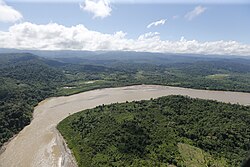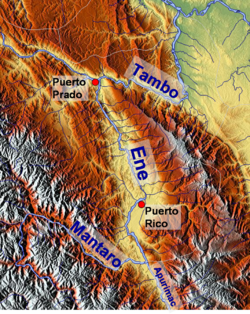Ene River
This articleneeds additional citations forverification.(December 2009) |


TheEne River(Spanish:Río Ene;Quechua:Iniy mayu) is aPeruvianriveron the eastern slopes of theAndes.It is aheadwaterof theAmazon River.
Geography
[edit]Headwaters
[edit]The Ene is formed at12°15′45″S73°58′30″W/ 12.26250°S 73.97500°Wat the confluence of theMantaro Riverand theApurímac River,circa 400 m above sea level, where the three Peruvian RegionsJunín,Cusco,andAyacuchomeet.
The river flows in a northwesterly direction at a total length of 180.6 km (112.2 mi).
The Ene River is part of theheadwatersof theAmazon Riverwhose origin is at theMismi,south of the city ofCuscowhere it first becomesApurímac River,then the Ene River andTambo Riverbefore its waters meet theUcayali Riverwhich later forms the Amazon.
At11°09′39″S74°14′48″W/ 11.16083°S 74.24667°Wthe Ene River joins thePerené Riverat the townPuerto Prado,295 m (968 ft) above sea level, and is called the Tambo from then on.
Threats
[edit]The proposed 2,200-megawatt Pakitzapango hydroelectric dam would flood much of the Ene River valley.[1]Protests by the CentralAshaninkadel Rio Ene (CARE, Asháninka Center of the Ene River) andRuth Buendia(president since 2005) have halted the construction.[1][2]For her efforts, Buendia was awarded theGoldman Environmental Prizein 2014.[3][2]
References
[edit]- ^ab"Pakitzapango Dam".International Rivers.RetrievedApril 30,2016.
- ^abMonti Aguirre (April 28, 2014)."Ruth Buendía of Peru Wins 2014 Goldman Environmental Prize".International Rivers.RetrievedApril 30,2016.
- ^"Prize Recipient: Ruth Buendia, 2014 South & Central America".Goldman Environmental Prize.Retrieved3 June2014.
External links
[edit] Media related toEne Riverat Wikimedia Commons
Media related toEne Riverat Wikimedia Commons
